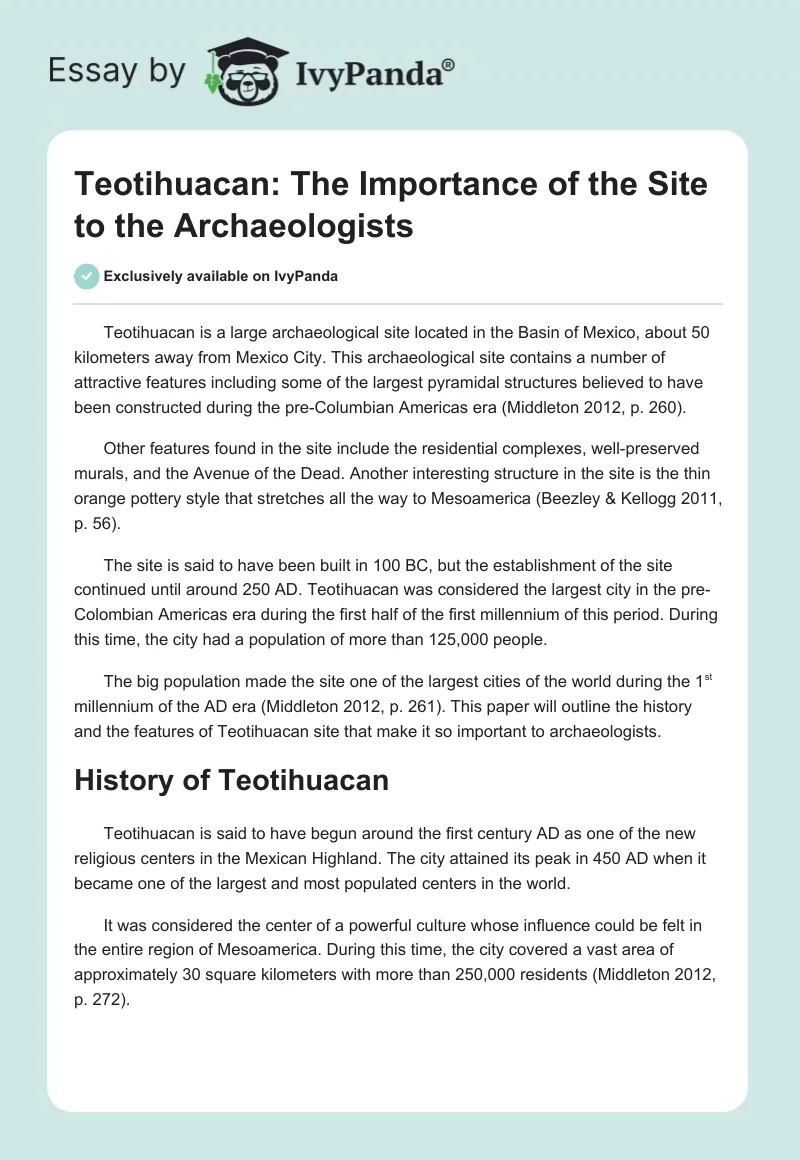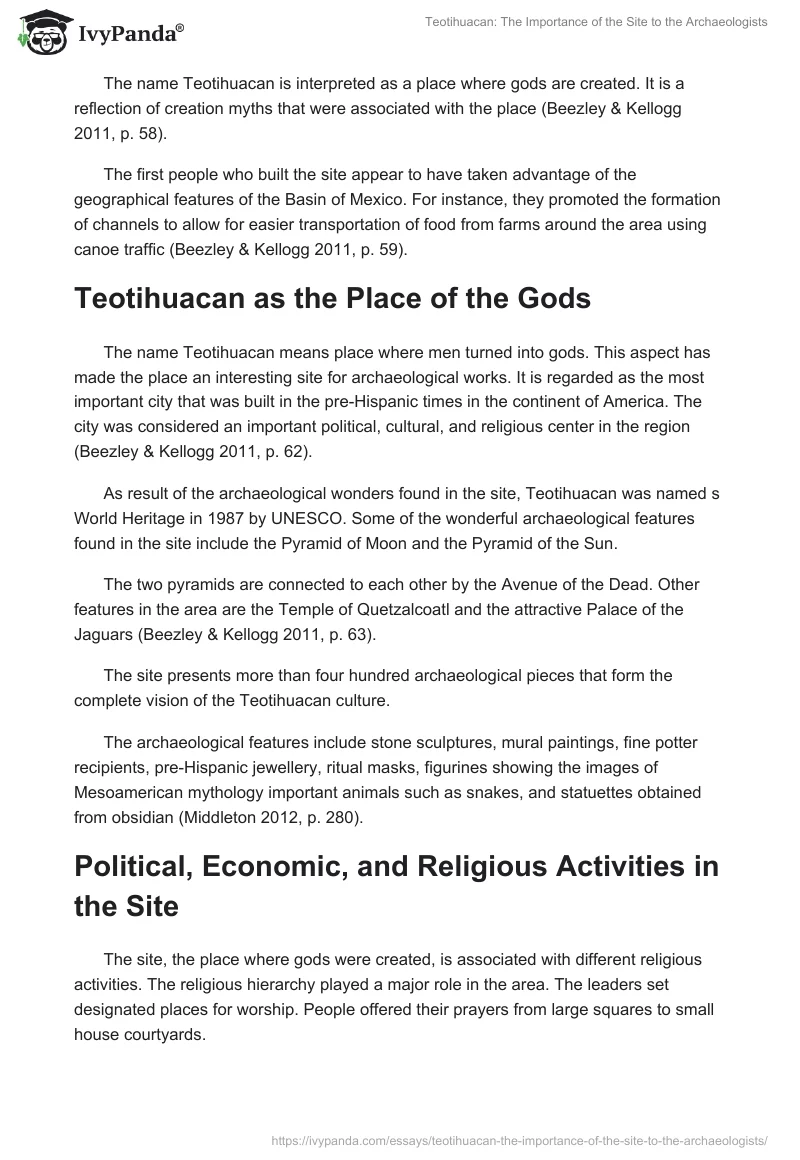Teotihuacan is a large archaeological site located in the Basin of Mexico, about 50 kilometers away from Mexico City. This archaeological site contains a number of attractive features including some of the largest pyramidal structures believed to have been constructed during the pre-Columbian Americas era (Middleton 2012, p. 260).
Other features found in the site include the residential complexes, well-preserved murals, and the Avenue of the Dead. Another interesting structure in the site is the thin orange pottery style that stretches all the way to Mesoamerica (Beezley & Kellogg 2011, p. 56).
The site is said to have been built in 100 BC, but the establishment of the site continued until around 250 AD. Teotihuacan was considered the largest city in the pre-Colombian Americas era during the first half of the first millennium of this period. During this time, the city had a population of more than 125,000 people.
The big population made the site one of the largest cities of the world during the 1st millennium of the AD era (Middleton 2012, p. 261). This paper will outline the history and the features of Teotihuacan site that make it so important to archaeologists.
History of Teotihuacan
Teotihuacan is said to have begun around the first century AD as one of the new religious centers in the Mexican Highland. The city attained its peak in 450 AD when it became one of the largest and most populated centers in the world.
It was considered the center of a powerful culture whose influence could be felt in the entire region of Mesoamerica. During this time, the city covered a vast area of approximately 30 square kilometers with more than 250,000 residents (Middleton 2012, p. 272).
The name Teotihuacan is interpreted as a place where gods are created. It is a reflection of creation myths that were associated with the place (Beezley & Kellogg 2011, p. 58).
The first people who built the site appear to have taken advantage of the geographical features of the Basin of Mexico. For instance, they promoted the formation of channels to allow for easier transportation of food from farms around the area using canoe traffic (Beezley & Kellogg 2011, p. 59).
Teotihuacan as the Place of the Gods
The name Teotihuacan means place where men turned into gods. This aspect has made the place an interesting site for archaeological works. It is regarded as the most important city that was built in the pre-Hispanic times in the continent of America. The city was considered an important political, cultural, and religious center in the region (Beezley & Kellogg 2011, p. 62).
As result of the archaeological wonders found in the site, Teotihuacan was named s World Heritage in 1987 by UNESCO. Some of the wonderful archaeological features found in the site include the Pyramid of Moon and the Pyramid of the Sun.
The two pyramids are connected to each other by the Avenue of the Dead. Other features in the area are the Temple of Quetzalcoatl and the attractive Palace of the Jaguars (Beezley & Kellogg 2011, p. 63).
The site presents more than four hundred archaeological pieces that form the complete vision of the Teotihuacan culture.
The archaeological features include stone sculptures, mural paintings, fine potter recipients, pre-Hispanic jewellery, ritual masks, figurines showing the images of Mesoamerican mythology important animals such as snakes, and statuettes obtained from obsidian (Middleton 2012, p. 280).
Political, Economic, and Religious Activities in the Site
The site, the place where gods were created, is associated with different religious activities. The religious hierarchy played a major role in the area. The leaders set designated places for worship. People offered their prayers from large squares to small house courtyards.
The main deities found in the area were Tialoc and Quetzalcoatl. Tialoc presided over rains and fertility while Quetzalcoatl was the plumed serpent. Other deities were usually located in houses in form of pottery sculptures and they included the Xipe Totec, fire god, and Huehueteotl (Carrsco 2009, p. 633).
The Teotihuacan society is said to have been divided into four categories; these categories included the dominant class, warriors, merchants, and the ordinary people. The dominant class was entitled to a lot of privileges and its members controlled education and the justice system in the area.
The warriors were accountable for the security of the area and they trained in handling various weapons. The craftsmen and merchants ruled the economy of the area while the construction works and farming were left to the ordinary people (Carrsco 2009, p. 633).
The palaces found in the site were constructed in such a way that they suited different family needs. The rooms in the palaces were grouped around courtyards and were of different sizes.
In each room, there was a family with retinues of craftsmen, merchants, and guards. The rooms in the palaces were assigned to people according to their social status. People who were considered high-class were given better rooms than ordinary people (Carrsco 2009, p. 634).
Teotihuacan Culture and Ethnicity
Most of the archaeological studies that have been carried out in the site suggest that Teotihuacan was a multi-ethnic region. The distinct quarters found in the site were occupied by Mixtec, Zapotec, Maya, Otomi, and Nahua people. It is believed that the Totonacs were the founders of the site since they were the first group to settle in the area and that the establishment was continued by the Aztecs (Middleton 2012, p. 283).
The most important ethnic group in Teotihuacan, according to the archaeological findings, was the Mixe-Zoquean and Totonacan linguistic affiliations. The spread of Mixe-Zoquean and Totonacan languages to other regions of Mesoamerica explains how strong the two groups were in the region (Beezley & Kellogg 2011, p. 73).
However, some archeologists have maintained that the largest population group in Teotihuacan must have been the Otomi. The archaeologists say that the Otomi language was spoken in the Teotihuacan surroundings before and after the classic periods (Beezley & Kellogg 2011, p. 76).
The Collapse of Teotihuacan
The collapse of the archaeological site is attributed to a number of factors. Some people hold that the Teotihuacan collapsed in the 7th century as a result of invasion by assailants who sacked and burnt the entire area.
Other archeologists feel that the decline and the final disappearance of the Teotihuacan population in the 6th century came as a result of the lengthy droughts caused by the extreme climatic changes that took place in 535-536 AD (Middleton 2012, p. 299).
In conclusion, the Teotihuacan archaeological site is unique in its own way, given that it had a very big population and it was considered a place where gods were made. The population was divided into four distinctions ranging from the high class to the low class.
It is not clear what really caused the disappearance of Teotihuacan. The uniqueness and uncertainties surrounding the site make it extremely important for archaeological studies.
References
Beezley, WH & Kellogg, S 2011, ‘The gods depart: riddles of the rise, fall, and regeneration of Mesoamerican indigenous societies’, Journal of American History and Culture, vol. 21, no. 7, pp. 56-71.
Carrsco, D 2009, ‘The Teotihuacan trinity: the sociopolitical structure of an ancient Mesoamerican city’, Journal of the Royal Anthological Institute, vol. 15, no. 3, pp. 633-634.
Middleton, GD 2012, ‘Nothing lasts forever: environmental discourses on the collapse of past societies’, Journal of Archaeological Research, vol. 20, no. 3, pp. 257-307.


